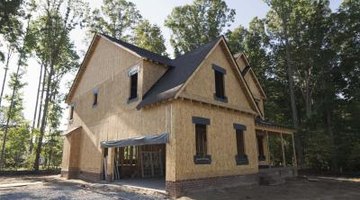Materials List for Framing a House
The framing process of a house takes place after the foundation has been laid but before electrical and plumbing utilities are installed. Think of the frame as the building’s skeleton. The materials provide support for the walls and roof, so accurate framing is very important. Poor quality framing will lead to squeaky floors, doors that don’t close properly and walls that are not completely flat.
Lumber

Lumber is the most common framing material used in house construction. Wooden floor joists are traditionally made from 2-by-8-inch or 2-by-12-inch boards. Some floor joists are made from composite “I” beams rather than traditional lumber. Plywood is nailed or screwed to the floor joists to form a sub-floor. Lumber is also used to frame the walls, with 2-by-4-inch boards being the most common choice. Sill plates sit under the wall and prevent the wall from sliding. Sill plates are often made of 2-by-4-inch boards.
Fasteners
Fasteners of various kinds are used to hold the framing materials together. Fasteners typically include nails, screws and glue. Anchor bolts and hold-down straps are used to secure the wall structure to the foundation. Rim joist hangers are used to connect the floor joists. Nails and glue are sometimes used to connect the rest of the framing materials together. Screws can be used for this purpose instead.
Roof Trusses
Roof trusses are used to frame the roof. Trusses are constructed of lumber and are usually built off-site. They are installed after transportation to the building site. Roof trusses require a lot of engineering, as they must be able to sustain various kinds of load throughout the life of the house. Building inspectors may ask to see truss engineering calculations when inspecting the framing.
Sheathing
Sheathing materials, attached to the exterior of the wall frames, are used to make the walls stronger and provide a base to attach the siding. Sheathing can be made from a number of materials, including exterior gypsum board, waferboard, Oriental strand board and plywood. Sheathing materials also include house wrap. House wrap is applied on top of the other sheathing materials. It is used to slow air leakage and to act as a waterproof barrier.
References
Writer Bio
Mike Davey has been writing and editing professionally since 1996. His work has appeared in "Owl" magazine, "Sposa," "STUDENTBody" and numerous B2B publications such as "Collision Repair" magazine, "Canadian Rental Service" and "Glass Canada."
Photo Credits
- Jupiterimages/Comstock/Getty Images
More Articles



